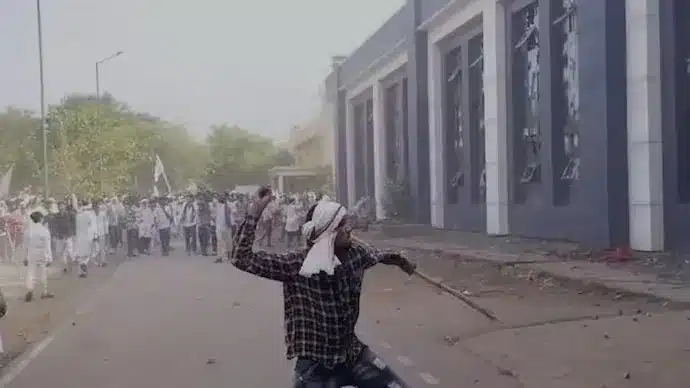What’s in today’s article?
- Why in News?
- Who is the Satnamis Community?
- History of Protest of Satnamis Community – Revolt of 1672
- Revival of the Satnamis
Why in News?
- A huge mob from the Satnami community torched dozens of vehicles, pelted police personnel with stones and set afire the Superintendent of Police office building in Chhattisgarh’s Baloda Bazar district.
- The protesters were not satisfied with the police’s handling of a case (and demanding a CBI probe) involving the desecration of a ‘Jaitkhamb’, a structure of sacred importance to the Satnamis.
Who is the Satnamis Community?
- Satnamis (believes in God whose name is ‘truth’) are a predominant group within the 11% Scheduled Caste (SC)population in Chhattisgarh and who are believed to be an offshoot of the Ravidassia community.
- The community was founded on April 21, 1657 by Bir Bhan of Narnaul, Haryana. Udhodas, a disciple of Saint Ravidas, was the first priest or spiritual guru of the society.
- The community inhabits the plains of the state’s central region, mostly the old districts of Bilaspur, Durg, Rajnandgaon and Raipur.
- The sect emphasises on three principles – adorn the attire of a Satnami devotee, earn money through proper means and do not tolerate any injustice or oppression in any form.
- There is a belief that the Satnamis exert political influence by voting collectively.
- The majority of the 10 assembly segments allotted for SCs are occupied by community representatives.
- The community reveres Mini Mata – the first female Member of Parliament from Chhattisgarh, who entered the Lok Sabha by winning the 1955 by-election.
- Invoking her, political parties appeal to Satnamis for votes.
History of Protest of Satnamis Community – Revolt of 1672:
- The Satnami revolt occurred in the reign of the Mughal Emperor Aurangzeb and around what is today’s Mahendragarh district of Haryana.
- The revolt began when a Mughal soldier killed a Satnami and the result was that about 5,000 Satnamis were up in arms.
- They routed the Mughal troops situated in the town, drove away the Mughal administrators and set up their own administration in its place.
- The uprising gained the enthusiasm of Hindus in Agra and Ajmer also, as they were not happy with Aurungzeb’s strict Islamic policies, which included
- Reviving the Jizya tax (poll tax on non-Muslim subjects),
- Banning music and art, and
- Destroying Hindu temples.
- When the Satnamis inflicted several defeats on the Mughal forces, Aurungzeb himself took personal command and sent troops with artillery to suppress the revolt.
- What followed was an attempt to kill every remaining member of the Satnamis. The remnants of the Satnamis fled in all directions, who remained totally disorganised and leaderless for a long time.
Revival of the Satnamis:
- The most important Satnami group was founded in 1820 in the Chhattisgarh region of central India by Saint Ghasidas, a farm servant and member of the lower (Chamar) caste.
- His Satnam Panth (“Sect of the True Name”) succeeded in providing a religious and social identity for large numbers of members of Satnamis.
- Saint Ghasidas preached a code of ethical and dietary self-restraint and social equality and wrote Nirvan Gyan to propagate his teachings.
As a result of connections with the Kabir Panth at different points in history, Satnamis have complicatedly navigated their position within a larger Hindu hierarchy.
Q.1. Why was the Self-Respect Movement launched in pre-independent India?
The Self-Respect Movement originated in South India for achieving social equality for those oppressed by the Indian caste system. It was founded in 1925 by S. Ramanathan who invited E. V. Ramasamy to lead the movement in Tamil Nadu, India, against Brahminism.
Q.2. Why was the Depressed Classes Movement (Mahar Movement) launched in pre-independent India?
B R Ambedkar launched the Depressed Classes Movement in 1924 with the goals of uplifting the downtrodden sections and abolition of untouchability.
Source: Satnamis protest desecration; attack SP office, torch vehicles in Chhattisgarh | The Mooknayak
Last updated on December, 2025
→ Check out the latest UPSC Syllabus 2026 here.
→ Join Vajiram & Ravi’s Interview Guidance Programme for expert help to crack your final UPSC stage.
→ UPSC Mains Result 2025 is now out.
→ UPSC Notification 2026 is scheduled to be released on January 14, 2026.
→ UPSC Calendar 2026 is released on 15th May, 2025.
→ The UPSC Vacancy 2025 were released 1129, out of which 979 were for UPSC CSE and remaining 150 are for UPSC IFoS.
→ UPSC Prelims 2026 will be conducted on 24th May, 2026 & UPSC Mains 2026 will be conducted on 21st August 2026.
→ The UPSC Selection Process is of 3 stages-Prelims, Mains and Interview.
→ UPSC Result 2024 is released with latest UPSC Marksheet 2024. Check Now!
→ UPSC Prelims Result 2025 is out now for the CSE held on 25 May 2025.
→ UPSC Toppers List 2024 is released now. Shakti Dubey is UPSC AIR 1 2024 Topper.
→ UPSC Prelims Question Paper 2025 and Unofficial Prelims Answer Key 2025 are available now.
→ UPSC Mains Question Paper 2025 is out for Essay, GS 1, 2, 3 & GS 4.
→ UPSC Mains Indian Language Question Paper 2025 is now out.
→ UPSC Mains Optional Question Paper 2025 is now out.
→ Also check Best IAS Coaching in Delhi

















